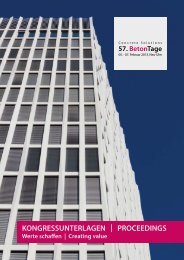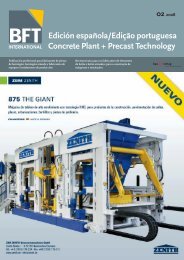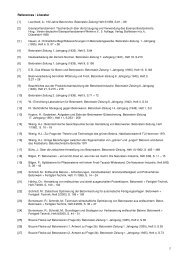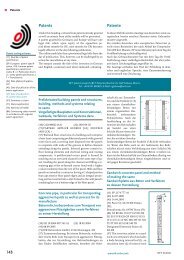Concrete Plant + Precast Technology Betonwerk ... - BFT International
Concrete Plant + Precast Technology Betonwerk ... - BFT International
Concrete Plant + Precast Technology Betonwerk ... - BFT International
Erfolgreiche ePaper selbst erstellen
Machen Sie aus Ihren PDF Publikationen ein blätterbares Flipbook mit unserer einzigartigen Google optimierten e-Paper Software.
30<br />
Panel 1<br />
The reference – an offi ce building with underground car park<br />
Building material<br />
Das Referenzbeispiel – Bürogebäude mit Tiefgarage<br />
Baustoff e<br />
Autor<br />
Dr. rer. nat. Bruno Hauer,<br />
Forschungsinstitut der Zementindustrie,<br />
Düsseldorf<br />
ha@vdz-online.de<br />
Geb. 1965; Studium der Physik<br />
an der Universität Bonn;<br />
1992–1995 Doktorand am Forschungszentrum<br />
Jülich;<br />
seit 1996 wiss. Mitarbeiter am<br />
Forschungsinstitut der<br />
Zementindustrie und insbesondere<br />
für Fragen des nachhaltigen<br />
und ökologischen Bauens<br />
und des Einsatzes von Ökobilanzen<br />
im Bauwesen zuständig;<br />
seit 2000 Leiter des Referats<br />
„Nachhaltiges Bauen“.<br />
Environmental impact indicators such as the potential<br />
contribution to the greenhouse eff ect are key components<br />
of any sustainability assessment that covers the entire life<br />
cycle of a building or structure. In order to determine such<br />
indicators for a building, environmental impact profi les<br />
must be available for the production of the most important<br />
building materials used. In the case of a concrete<br />
structure, these primarily include cement, concrete and<br />
reinforcing steel.<br />
A building material profi le was thus established for an<br />
average cement in Germany. Without further specifi cation<br />
of the type of cement, this profi le enables the preparation<br />
of a more comprehensive profi le of the concrete and<br />
the structural components made thereof. For this building<br />
material profi le, 1 ton of a cement representing the<br />
average of the German cement production in 2006 was<br />
defi ned as a reference. The composition of this cement<br />
corresponds to the mean quantities of the cement constituents<br />
used in Germany. Average values for Germany<br />
were also applied to the other input parameters used for<br />
the environmental impact assessment. For instance, the<br />
consumption of electricity was defi ned as the mean consumption<br />
documented for the production of 1 ton of cement<br />
in Germany. For the production of Portland cement<br />
clinker, the mean fuel energy consumed on the basis of<br />
the 2006 fuel mix was used. Also, the mean carbon emission<br />
levels generated per ton of clinker at the cement plant<br />
were considered, as well as mean transport distances for<br />
the raw materials for cement production. In order to assess<br />
the infl uence of the type of cement in sensitivity analyses,<br />
building material profi les were prepared for several<br />
specifi c types of cement on the basis of typical compositions.<br />
Starting from the building material profi le of cement,<br />
corresponding profi les for concretes of the three compressive<br />
strength classes C 20/25, C 25/30 and C 30/37 were<br />
prepared jointly with the Bundesverband der Deutschen<br />
Transportbetonindustrie e.V. (Federal Association of the<br />
German Ready-Mixed <strong>Concrete</strong> Industry) and fed into the<br />
research. In addition, the project included the calculation<br />
of additional building material profi les for concretes of<br />
higher strength classes. In this exercise, the building material<br />
profi les were derived from concrete mix designs<br />
with contents of cement, aggregates and other constituents<br />
that are typical of these compressive strength classes.<br />
In the fi nal step, the building material profi le for 1 ton<br />
of reinforcing steel was calculated for the year of 2007 in<br />
coordination with the Institut für Stahlbetonbewehrung<br />
e.V. (Institute for <strong>Concrete</strong> Steel Reinforcement), using<br />
the data of a reinforcing steel plant representative of the<br />
production in Germany. For this purpose, an electric steel<br />
plant was evaluated in which reinforcing steel is produced<br />
from scrap since this is the only production method common<br />
in Germany. This analysis was not only restricted to<br />
| Proceedings 54 th BetonTage<br />
Ökobilanzielle Indikatoren wie der potenzielle Beitrag<br />
zum Treibhauseff ekt sind wesentliche Bausteine einer<br />
Nachhaltigkeitsbetrachtung über den gesamten Lebenszyklus<br />
eines Bauwerks. Um solche Indikatoren für ein<br />
Bauwerk ermitteln zu können, ist die Verfügbarkeit von<br />
ökobilanziellen Profi len für die Herstellung der wesentlichen<br />
Baustoff e unumgänglich. Im Falle eines Betonbauwerks<br />
betriff t dies insbesondere die Baustoff e Zement,<br />
Beton und Betonstahl.<br />
Vor diesem Hintergrund wurde ein Baustoff profi l für<br />
einen durchschnittlichen Zement in Deutschland erstellt.<br />
Dieses Baustoff profi l ermöglicht ohne genauere Festlegung<br />
der Zementart die Erstellung eines weitergehenden<br />
Profi ls von Beton und den daraus erstellten Bauteilen. Als<br />
Bezugsgröße dieses Baustoff profi ls wurde 1 t eines Zements<br />
defi niert, der den Durchschnitt der deutschen Zementproduktion<br />
im Jahr 2006 repräsentiert und entsprechend<br />
den in Deutschland mengenmäßig im Mittel<br />
eingesetzten Zementbestandteilen zusammengesetzt ist.<br />
Auch für die anderen Eingangsgrößen der Ökobilanz<br />
wurden für Deutschland durchschnittliche Werte verwendet.<br />
So wurde der Stromverbrauch angesetzt, der in<br />
Deutschland im Mittel zur Herstellung 1 t Zement benötigt<br />
wird. Für die Portlandzementklinkerherstellung wurde<br />
der mittlere Einsatz an Brennstoff energie unter Berücksichtigung<br />
des Brennstoff mixes des Jahres 2006<br />
angesetzt. Ebenso wurden die mittleren Emissionen, die<br />
im Zementwerk pro t Klinker entstehen sowie mittlere<br />
Transportentfernungen für die Ausgangsstoff e des Zements<br />
herangezogen. Um den Einfl uss der Zementart in<br />
Sensitivitätsanalysen überprüfen zu können, wurden ergänzend<br />
für einzelne Zementarten ausgehend von typischen<br />
Zusammensetzungen Baustoff profi le bestimmt.<br />
Aufbauend auf das Baustoff profi l Zement konnten<br />
gemeinsam mit dem Bundesverband der Deutschen<br />
Transportbetonindustrie e.V. entsprechende Baustoff profi<br />
le für Betone der drei Betondruckfestigkeitsklassen C<br />
20/25, C 25/30 und C 30/37 entwickelt und in das Vorhaben<br />
eingespeist werden. Darüber hinaus wurden im Vorhaben<br />
weitere Baustoff profi le für Betone höherer Druckfestigkeitsklassen<br />
berechnet. Die Baustoff profi le bauen<br />
dabei auf Betonrezepturen mit für diese Betondruckfestigkeitsklassen<br />
typischen Gehalten an Zement, Gesteinskörnungen<br />
und anderen Betonbestandteilen auf.<br />
Schließlich wurde in Abstimmung mit dem Institut für<br />
Stahlbetonbewehrung e.V., ausgehend von den Daten eines<br />
für die Produktion in Deutschland typischen Betonstahlwerkes,<br />
das Baustoff profi l für 1 t Betonstahl für das Jahr<br />
2007 berechnet. Dabei wurde ein Elektrostahlwerk betrachtet,<br />
das den Betonstahl aus Schrott herstellt, da das in<br />
Deutschland das einzig gängige Herstellungsverfahren ist.<br />
Auch hier wurden nicht nur die Aufwendungen im Werk<br />
selbst betrachtet, sondern darüber hinaus auch die Aufwendungen<br />
in den Vorketten beispielsweise bei der Herstellung<br />
der erforderlichen Legierungen und der Elektroden.<br />
<strong>BFT</strong> 02/2010












